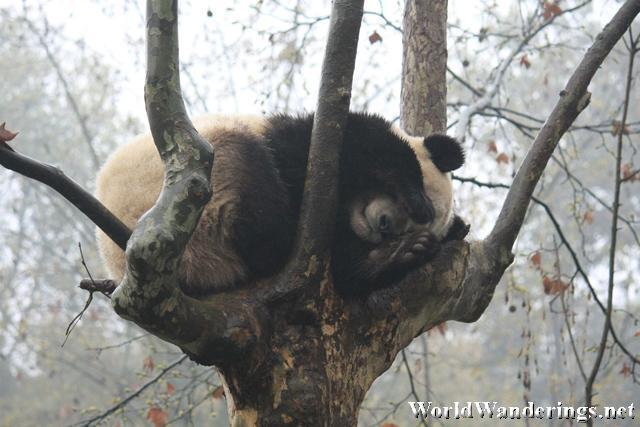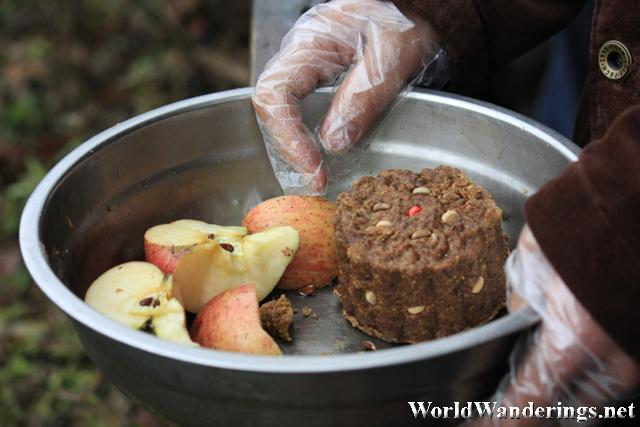After being turned from Jiuzhaigou, we decided to spend the next day exploring the charming city of Chengdu. One of the must-see places in Chengdu and the one it is famous for, is the Giant Panda Research Base. While this is not the giant panda sanctuary I was hoping to visit, that one is in Wolong 卧龙, which is unfortunately, off limits to us, this is a more accessible version of Wolong.
According to the travel guides, it would be tough to take public transport to the research base so we took a cab to the research base. The research base is some distance away from the city center of Chengdu, which was necessary since the pandas would need lots of fresh air and space to move around. The research base feels more like a park and a research base. However, a lot of serious research really goes on in this facility.
So why research on breeding specifically? Pandas are notoriously difficult to breed naturally, even if they decide to procreate, the young often do not survive. In the wild, pandas feed on a specific type of bamboo that grows only in the mountains of Sichuan. They are naturally very shy creatures. However, the continued encroachment of humans in their habitat has made the more and more difficult to find. Thus they also have difficulty finding each other and as a consequence mate even less. And to just to make life more interesting, the bamboo plants they feed on go through a mass dying every 20 years or so. With nothing to eat, the pandas starve and die, whittling down their numbers even more.
The Chinese government has responded to this threat to the giant panda by establishing wide swathes of protected land for the giant panda. They have also established research centers such as this one to help improve the survivability of the giant panda. China has also raised international awareness of the plight of the giant panda and how people can help preserve the species.
The main reason why visitors visit the giant panda research base is to get to see the fabled giant panda up close. The giant pandas are house in wide pens where they can walk about and do their thing. There is a deep trench which would prevent them from getting out of the pen. Because of this, there is no need to cages so the visitors get an unobstructed view of the giant pandas.
I must say that the giant pandas are truly adorable and I really couldn’t stop myself from taking shot after shot of them. We were lucky enough to witness feeding time. Apparently each of these pandas have their own caretaker and they would get fed by these caretakers everyday. Their food looks suspiciously like a mooncake but it is stuffed with tablet and capsules to make sure that they pandas get their vitamins. Bamboo apparently, is a poor source of nutrients which is why they need to consume huge amounts of bamboo everyday.
Interestingly, the panda can strip the tough outer layers of the bamboo with their thumb-like appendage, this can give the pandas access to the jiucy stuff underneath it. We would watch the panda just gorge themselves with bamboo and thinking how it would be wonderful to be a panda here in the base. People come everyday to adore you. You get fed with lots of bamboo everyday. You have your own personal caretaker. What a life.
Pandas here in the research base do not only come in black and white. There is also a red panda. A red panda actually looks more like a cross between racoon and a fox than a “regular” panda. Its fur is bright orange and it has a tail. If you haven’t heard of a red panda then maybe the name firefox would be ring a bell. Yes, a red panda is also called a firefox, just like the browser.
Visitors can get a chance to get even more close with a panda via pictorial session. The cheapest one would be a photo with a red panda. More expensive are the regular black and white pandas. I didn’t go for this but I contented myself to just admiring these immensely adorable creatures.
Near the exit of the reserach base is a souvenir station where you can buy, what else, stuff panda toys. I bought myself a shirt before heading out go to our next destination.
The panda research base is a worthwhile place to visit especially if you do not have the time to visit Wolong. This place become even more important with the destruction of the Wolong research base because of last year’s powerful earthquake. The pandas have now been relocated to various parts of China awaiting rehabilitation of their home. In the meantime, this is the best destination for pandas in all of China. Just be careful you don’t use up your storage photographing them.
[xmlgm {http://www.worldwanderings.net/kml/PandaResearchBase.kmz}]








